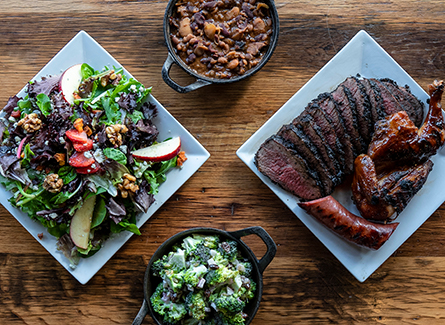Balance, Variety Is the Key to Healthy Meals and Snacks
October 7, 2024By: Lindsey Robinson
Categories: Nutrition

There is no magic pill or food that contains all the nutrients we need for a prosperous day. The key is to find a balanced diet that supplies your body with the nutrients it needs to work effectively.
The U.S. Department of Agriculture offers the MyPlate guide, suggesting a plate filled with equal portions of whole grains, lean protein, non-starchy vegetables and fruits. The MyPlate website offers budget-friendly and quick-and-easy recipes along with other resources to build a balanced diet.
One food doesn’t give you everything you need. Carbohydrates give you energy but are not filling. You’ll be hungry again in an hour or two. Protein is more filling, but it doesn’t supply energy. It is important to balance the two to get the benefit of both. And when the two balance out it helps with portion control.
Here is a look at the four groups, including examples and the benefits each provides.
Grains
Whole wheat and whole grain is healthier than white, refined grains, but sometimes the labeling can be deceptive. If you want to be sure you are getting whole wheat or whole grain, check the ingredients. If the first item is enriched or refined flour, then it is white bread.
|
Healthy Examples |
Benefits |
|
Bread |
Carbohydrates |
|
Rice |
Iron |
|
Pasta |
Fiber |
|
Tortillas |
B vitamins |
|
Oats |
|
|
Quinoa |
|
|
Crackers |
|
|
Starchy vegetables: Corn, potatoes, peas |
|
Lean Protein
How you prepare food is also important. Cut off all visible fat from all cuts of meat before cooking. When preparing ground beef or turkey, cook and drain the meat before adding seasoning. This method can also save you money.
Ideally, you want 90% lean or better for ground beef and turkey, but meat is expensive. If you get 80% lean and drain the fat, then that is still a great way to limit fat and be healthy.
Limit fried foods and cooking with saturated fats. Unsaturated fats are anti-inflammatory, heart healthy and include most cooking oils.
A good rule of thumb is anything that is liquid at room temperature will flow through the arteries. Anything solid at room temperature can clog the arteries. This includes butter, lard and shortening. If you’re going to grease a skillet, reach for an aerosol spray, not a stick of butter.
|
Healthy Examples |
Benefits |
|
Chicken |
Omega-3 fatty acids |
|
Turkey |
B vitamins |
|
Fish |
Vitamin E |
|
Eggs |
Iron |
|
Nuts |
Zinc |
|
Seeds |
Magnesium |
|
Beans |
|
|
Lean cuts of beef and pork (round and loin) |
Limit processed meats: bacon, sausage, lunch meat, hot dogs |
Fruits and Vegetables
Variety is the key, both in types of foods and how they are stored. Canned vegetables typically have a lot of added salt, so look for cans that have no salt added. If you can’t find that, rinse the canned vegetables off under water at home before preparing them.
Likewise, try to find fruits canned in water, not syrup. The second-best option is to buy fruit canned in its own juice, then drain it at home.
Fresh, frozen or canned — everything tastes different. Shop what’s in season for fresh items, then rotate between frozen and canned. It’s like eating a different food each time.
|
Non-starchy Vegetables |
|
|
Healthy Examples |
Benefits |
|
Lettuce |
Potassium |
|
Tomato |
Dietary fiber |
|
Cucumber |
Folate (important in red blood cell formation and for healthy cell growth) |
|
Broccoli |
Vitamin A |
|
Spinach |
Vitamin C |
|
Carrots |
|
|
Kale |
|
|
Zucchini |
|
|
Asparagus |
|
|
Mushrooms |
|
|
Bell peppers |
|
|
Fruits |
|
|
Healthy Examples |
Benefits |
|
Berries |
Potassium |
|
Melons |
Fiber |
|
100% fruit juice |
Vitamin C |
|
Citrus fruits |
Folate |
|
Peaches, apples, pears, etc. |
Low in fat, sodium and calories |
Creativity and balance are the keys to a healthy diet. Finding ways to blend foods from different groups makes the meal more interesting, but also brings important nutrients to the body.
Think about having bell peppers with hummus. If you have a salad, maybe add an apple. “Use your imagination. Go crazy. There are no side effects from eating healthy.



